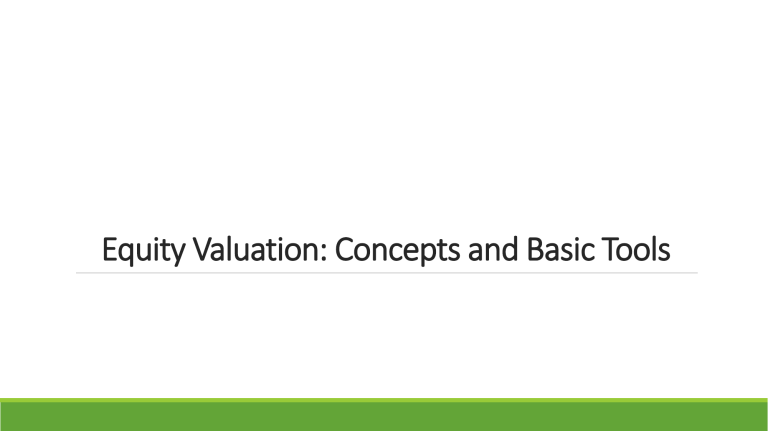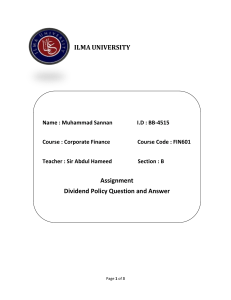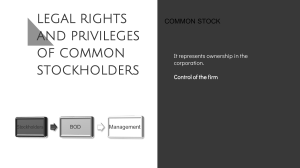
Equity Valuation: Concepts and Basic Tools Q1 An analyst finds that all the securities analyzed have estimated values higher than their market prices. The securities all appear to be: A overvalued. B undervalued. C fairly valued. Ans: undervalued Q2 An analyst finds that nearly all companies in a market segment have common shares which are trading at market prices above the analyst’s estimate of the shares’ values. This market segment is widely followed by analysts. Which of the following statements describes the analyst’s most appropriate first action? A Issue a sell recommendation for each share issue. B Issue a buy recommendation for each share issue. C Reexamine the models and inputs used for the valuations. Ans: C Q3 An analyst, using a number of models and a range of inputs, estimates a security’s value to be between $ 250 and $ 270. The security is trading at $ 265. The security appears to be: A overvalued. B undervalued. C fairly valued. Ans: C Q4 An analyst is estimating the intrinsic value of a new company. The analyst has one year of financial statements for the company and has calculated the average values of a variety of price multiples for the industry in which the company operates. The analyst plans to use at least one model from each of the three categories of valuation models. The analyst is least likely to rely on the estimate(s) from the: A multiplier model(s). B present value model(s). C asset-based valuation model(s). Ans: B Q5 Based on a company’s EPS of €1.35, an analyst estimates the intrinsic value of a security to be €16.60. Which type of model is the analyst most likely to be using to estimate intrinsic value? A Multiplier model. B Present value model. C Asset-based valuation model. Ans: A Intrinsic value of a share using DDM where V0 = value of a share of stock today, at t = 0 Dt = expected dividend in year t, assumed to be paid at the end of the year r = required rate of return on the stock The expected value of a share at the end of the investment horizon—in effect, the expected selling price—is often referred to as the terminal stock value (or terminal value). Q6 For the next three years, the annual dividends of a stock are expected to be €2.00, €2.10, and €2.20. The stock price is expected to be €20.00 at the end of three years. If the required rate of return on the shares is 10 percent, what is the estimated value of a share? Ans: 20.23 Q7 If an investor purchases shares on the company’s ex-dividend date, which of the following statements is accurate? A. The investor will receive the dividend when it is paid by the company B. The investor will not receive the dividend when it is paid by the company C. The investor will receive a portion of the dividend when paid by the company Ans: B IV of a share using FCFE model Q8 An investor expects a share to pay dividends of $3.00 and $3.15 at the end of Years 1 and 2, respectively. At the end of the second year, the investor expects the shares to trade at $40.00. The required rate of return on the shares is 8 percent. If the investor’s forecasts are accurate and the market price of the shares is currently $30, the most likely conclusion is that the shares are: A overvalued. B undervalued. C fairly valued. Ans: Undervalued (39.77) Q9 Two investors with different holding periods but the same expectations and required rate of return for a company are estimating the intrinsic value of a common share of the company. The investor with the shorter holding period will most likely estimate a: A lower intrinsic value. B higher intrinsic value. C similar intrinsic value. Ans: C Q10 An equity valuation model that focuses on expected dividends rather than the capacity to pay dividends is the: A dividend discount model. B free cash flow to equity model. C cash flow return on investment model. Ans: A Required rate of return in PV models - CAPM Required rate of return on share = Current expected risk − free rate of return + Beta [Market equity risk premium] Rf + β * (Rm – Rf) Valuation of Preferred Stock For a non-callable, non-convertible perpetual preferred share paying a level dividend D and assuming a constant required rate of return, V0 = D0/r Eg: $100 par value non-callable perpetual preferred stock offers an annual dividend of $5.50. If its required rate of return is 6 percent, what will be its value estimate? Ans: $5.50/0.06 = $91.67. For a non-callable, non-convertible preferred stock, For a non-callable, non-convertible preferred stock with maturity at time n, Q11 What is the value of a non-convertible preferred stock with a par value of £20.00, maturity in six years, a nominal required rate of return of 8.20 percent, and semiannual dividends of £2.00 Ans: 31.01 Q12 The following facts concerning the Union Electric Company 4.75 percent perpetual preferred shares (CUSIP identifier: 906548821) are as follows: ■ Issuer: Union Electric Co. (owned by Ameren) ■ Par value: US$100 ■ Dividend: US$4.75 per year ■ Maturity: perpetual ■ Embedded options: none ■ Credit rating: Moody’s Investors Service/Standard & Poor’s Ba1/BB ■ Required rate of return on Ba1/BB rated preferred shares as of valuation date: 7.5 percent A Estimate the intrinsic value of this preferred share. B Explain whether the intrinsic value of this issue would be higher or lower if the issue were callable (with all other facts remaining unchanged). Shares with retraction option (putable shares) The holder of the shares has a put option Shares traded above par value – investors hold them Below the par value – Investors can sell them back to investor The Gordon Growth Model The assumptions of the Gordon model ■■ Dividends are the correct metric to use for valuation purposes. ■■ The dividend growth rate is forever: It is perpetual and never changes. ■■ The required rate of return is also constant over time. ■■ The dividend growth rate is strictly less than the required rate of return. Some alternatives to using the Gordon model ■■ Use a more robust DDM that allows for varying patterns of growth. ■■ Use a cash flow measure other than dividends for valuation purposes. ■■ Use some other approach (such as a multiplier method) to valuation. Ans: 72.67 Ans: 30.05 A company does not currently pay a dividend but is expected to begin to do so in five years (at t = 5). The first dividend is expected to be $4.00 and to be received five years from today. That dividend is expected to grow at 6 percent into perpetuity. The required return is 10 percent. What is the estimated current intrinsic value? Ans: 68.30 The current dividend, D0, is $5.00. Growth is expected to be 10 percent a year for three years and then 5 percent thereafter. The required rate of return is 15 percent. Estimate the intrinsic value The current dividend, D0, is $2.00. Growth is expected to be 15 percent a year for four years, 10% per year for next 3 years and stabilizes at 5 percent thereafter. The required rate of return is 12 percent. Estimate the intrinsic value MULTIPLIER MODELS Price multiple - ratio that compares the share price with some sort of monetary flow or value to allow evaluation of the relative worth of a company’s stock. Price-to-earnings ratio (P/E) Price-to-book ratio (P/B). Price-to-sales ratio (P/S). Price-to-cash flow ratio (P/CF). (Trailing Vs Leading/Forward/estimated) Justified value of a multiple P/E vs Required rate of return and Growth rate Dividend displacement of earnings






